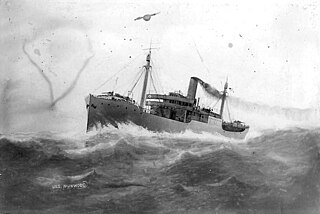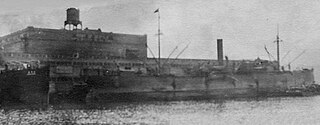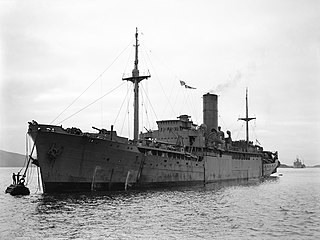
Jun'yō Maru (順陽丸) was a cargo steamship that was built in Scotland in 1913, served a succession of British owners until 1927, and was then in Japanese ownership until a Royal Navy submarine sank her in 1944.

Ryusei Maru was a cargo steamship that was built in England in 1911 and sunk off the coast of Bali in 1944. She was launched as Bra-Kar for Fred. Olsen & Co. of Norway. In 1916 she changed owners and was renamed Havø. In 1935 she changed owners again and was renamed Mabuhay II.

Kościuszko was a passenger steamship that was built in Scotland in 1915, sailed as a troopship in both World Wars, was an ocean liner between the wars, carried displaced persons after World War II and was scrapped in England in 1950.

SS Akaroa was a UK steam ocean liner and refrigerated cargo ship. She was launched in 1914 in Ireland as Euripides for Aberdeen Line. When new, she was the largest ship in the Aberdeen Line fleet.
SS Chenab was a steamship that was built in England in 1911 and scrapped in Scotland in 1953. For nearly two decades she was part of Nourse Line, which carried Girmityas from India to colonies in the Caribbean and the Pacific. In 1914 she was requisitioned for service in the First World War.

USS Argonne was a cargo steamship that was built in Japan in 1916 as Taifuku Maru No. 1. She served in the United States Navy from October 1918 to January 1919. In 1922 a French company bought her and renamed her Calonne. In 1922 an Italian company bought her and renamed her Wally. She was scrapped in Italy in 1935.

USS Zuiderdijk was a cargo ship that was built in England in 1912 as Sharistan, but was renamed Zuiderdijk later that year when she changed owners. She was USS Zuiderdijk with the Naval Registry Identification Number ID-2724, from 1918 until 1919. She was renamed Misty Law in 1923, Edera in 1931, Frin in 1956 and Mahfuz later in 1956.

HMS Port Quebec was a British motor ship that was designed and launched in 1939 to be the refrigerated cargo ship Port Quebec, but completed in 1940 as an auxuiliary minelayer. In 1944 she was converted into an aircraft component repair ship and renamed HMS Deer Sound. In 1947 she was returned to her owner, Port Line, and completed as a cargo ship. She was scrapped in Taiwan in 1968.

USS Charlton Hall (ID-1359) was a cargo steamship that was built in Scotland in 1907 and served in the merchant fleets of the United Kingdom, United States and Greece. She served in the United States Navy in 1918. She was renamed Atlantis and then Anastasis in 1930. She was scrapped in China in 1934.

USS Munwood (ID-4460) was a cargo steamship that was built in Scotland in 1914 and was part of the United States Merchant Marine until 1928. From 1918 to 1919 she served in the United States Navy. In 1928 Yugoslav interests bought her and renamed her Vila. In 1935 she sank as the result of a collision in the Adriatic Sea.

SS Polar Chief was a merchant steamship that was built in England in 1897 and scrapped in Scotland in 1952. In her 55-year career she had previously been called Montcalm, RFA Crenella, Crenella, Rey Alfonso, Anglo-Norse and Empire Chief. Early in the First World War she spent eight months pretending to be the battleship HMS Audacious.

USS Eastern Light (ID-3538) was an Emergency Fleet Corporation (EFC) Design 1127 cargo steamship that was built in Japan in 1918 for the United States Shipping Board (USSB). From December 1918 to April 1919 she spent five months in the United States Navy. In 1926 she was sold and renamed Willkeno. She was renamed Isthmian in 1937 and Illinoian in 1939. in 1944 she was scuttled off the coast of Normandy as Blockship 485.

USS Eastern Queen (ID–3406) was a cargo steamship. She was built in Japan in 1918 as Tofuku Maru, and bought that year by the United States Shipping Board (USSB), who renamed her Eastern Queen. From October 1918 to April 1919 she spent six months in the United States Navy as USS Eastern Queen, carrying cargo between the East Coast of the United States and France.

SS Themistocles was a UK steam ocean liner and refrigerated cargo ship. She was launched in 1910 in Ireland and scrapped in 1947 in Scotland. She was built for Aberdeen Line, White Star Line managed her for a few years, and she spent the latter part of her career with Shaw, Savill & Albion Line.

HMS Agamemnon was originally the Blue Funnel Line refrigerated cargo ship Agamemnon. She was built in 1929, traded between the UK and the Far East, and was scrapped in 1963. During the Second World War she was converted into an auxiliary minelayer in 1940, and then into an amenities ship in 1943.
The Hillcone Steamship Company was a United States based steamship company that operated from 1929 to 1970. It was based in San Francisco, California and was owned by businessmen Joseph J. Coney and Stanley Hiller, Sr. Ships it is known to have owned include the USS William Isom (ID-1555), which it had acquired by 1931 when it was renamed the Edwin B. De Golia. It also bought the USS Sangamon after she was decommissioned on October 24, 1945.
TSS City of Belfast was a passenger steamship that was built in England in 1893, renamed Nicolaos Togias in 1925, renamed Kephallinia in 1933 and sank in 1941. She was owned and registered in Britain until 1925, when she passed to Greek owners.
SS Santa Fé was a German refrigerated cargo steamship. She is now a Black Sea shipwreck and part of her cargo is of interest to marine archaeologists.

SS Demosthenes was a UK steam ocean liner and refrigerated cargo ship. She was launched in 1911 in Ireland for Aberdeen Line and scrapped in 1931 in England. In the First World War she was an Allied troop ship.

Empire Mariner was a cargo steamship. She was built in Germany in 1922 for Hamburg America Line (HAPAG), who named her Schwarzwald. In 1935 H. Vogemann bought her and renamed her Rheingold. In October 1939 a Royal Navy cruiser captured her, and the United Kingdom government renamed her as the Empire ship Empire Mariner. She survived numerous transatlantic convoys in the Battle of the Atlantic. In 1946 South American Saint Line bought her and renamed her Saint Ina. In 1948 Bristol City Line bought her and renamed her Wells City. In 1951 the Pakistani-owned East & West Steamship Company bought her and renamed her Fausta. She was scrapped in Pakistan in 1964.















